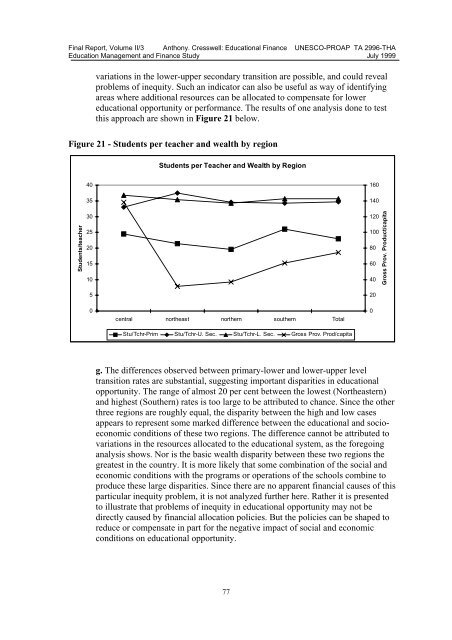Educational Finance in Thailand - UNESCO Bangkok
Educational Finance in Thailand - UNESCO Bangkok
Educational Finance in Thailand - UNESCO Bangkok
You also want an ePaper? Increase the reach of your titles
YUMPU automatically turns print PDFs into web optimized ePapers that Google loves.
F<strong>in</strong>al Report, Volume II/3 Anthony. Cresswell: <strong>Educational</strong> <strong>F<strong>in</strong>ance</strong> <strong>UNESCO</strong>-PROAP TA 2996-THA<br />
Education Management and <strong>F<strong>in</strong>ance</strong> Study July 1999<br />
variations <strong>in</strong> the lower-upper secondary transition are possible, and could reveal<br />
problems of <strong>in</strong>equity. Such an <strong>in</strong>dicator can also be useful as way of identify<strong>in</strong>g<br />
areas where additional resources can be allocated to compensate for lower<br />
educational opportunity or performance. The results of one analysis done to test<br />
this approach are shown <strong>in</strong> Figure 21 below.<br />
Figure 21 - Students per teacher and wealth by region<br />
Students per Teacher and Wealth by Region<br />
Students/teacher<br />
40<br />
35<br />
30<br />
25<br />
20<br />
15<br />
10<br />
5<br />
0<br />
central northeast northern southern Total<br />
Stu/Tchr-Prim Stu/Tchr-U. Sec. Stu/Tchr-L. Sec. Gross Prov. Prod/capita<br />
160<br />
140<br />
120<br />
100<br />
80<br />
60<br />
40<br />
20<br />
0<br />
Gross Prov. Product/capita<br />
g. The differences observed between primary-lower and lower-upper level<br />
transition rates are substantial, suggest<strong>in</strong>g important disparities <strong>in</strong> educational<br />
opportunity. The range of almost 20 per cent between the lowest (Northeastern)<br />
and highest (Southern) rates is too large to be attributed to chance. S<strong>in</strong>ce the other<br />
three regions are roughly equal, the disparity between the high and low cases<br />
appears to represent some marked difference between the educational and socioeconomic<br />
conditions of these two regions. The difference cannot be attributed to<br />
variations <strong>in</strong> the resources allocated to the educational system, as the forego<strong>in</strong>g<br />
analysis shows. Nor is the basic wealth disparity between these two regions the<br />
greatest <strong>in</strong> the country. It is more likely that some comb<strong>in</strong>ation of the social and<br />
economic conditions with the programs or operations of the schools comb<strong>in</strong>e to<br />
produce these large disparities. S<strong>in</strong>ce there are no apparent f<strong>in</strong>ancial causes of this<br />
particular <strong>in</strong>equity problem, it is not analyzed further here. Rather it is presented<br />
to illustrate that problems of <strong>in</strong>equity <strong>in</strong> educational opportunity may not be<br />
directly caused by f<strong>in</strong>ancial allocation policies. But the policies can be shaped to<br />
reduce or compensate <strong>in</strong> part for the negative impact of social and economic<br />
conditions on educational opportunity.<br />
77

















